climate control CADILLAC ESCALADE 2008 3.G User Guide
[x] Cancel search | Manufacturer: CADILLAC, Model Year: 2008, Model line: ESCALADE, Model: CADILLAC ESCALADE 2008 3.GPages: 490, PDF Size: 2.65 MB
Page 163 of 490
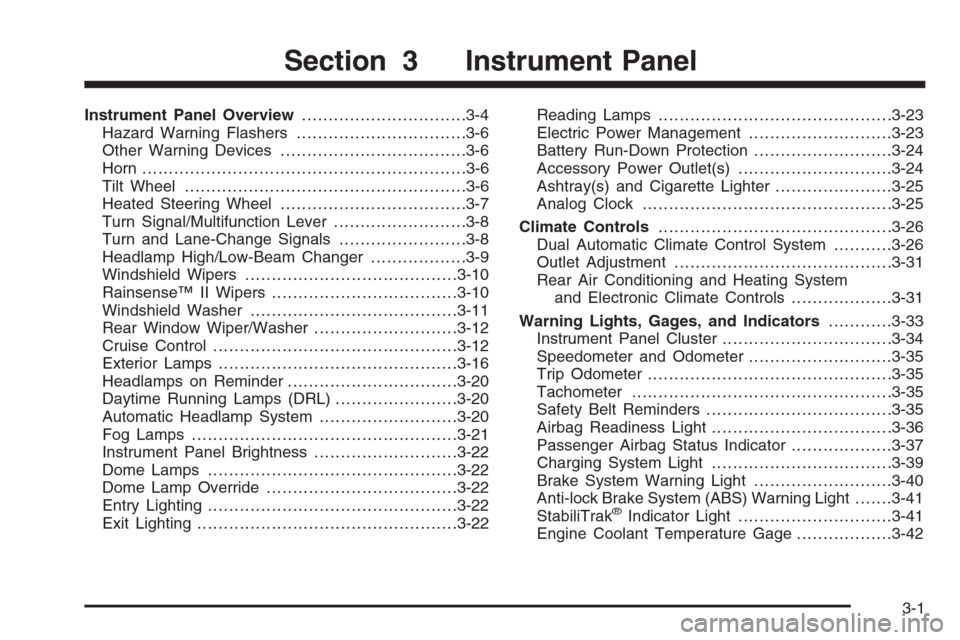
Instrument Panel Overview...............................3-4
Hazard Warning Flashers................................3-6
Other Warning Devices...................................3-6
Horn .............................................................3-6
Tilt Wheel.....................................................3-6
Heated Steering Wheel...................................3-7
Turn Signal/Multifunction Lever.........................3-8
Turn and Lane-Change Signals........................3-8
Headlamp High/Low-Beam Changer..................3-9
Windshield Wipers........................................3-10
Rainsense™ II Wipers...................................3-10
Windshield Washer.......................................3-11
Rear Window Wiper/Washer...........................3-12
Cruise Control..............................................3-12
Exterior Lamps.............................................3-16
Headlamps on Reminder................................3-20
Daytime Running Lamps (DRL).......................3-20
Automatic Headlamp System..........................3-20
Fog Lamps ..................................................3-21
Instrument Panel Brightness...........................3-22
Dome Lamps ...............................................3-22
Dome Lamp Override....................................3-22
Entry Lighting...............................................3-22
Exit Lighting.................................................3-22Reading Lamps............................................3-23
Electric Power Management...........................3-23
Battery Run-Down Protection..........................3-24
Accessory Power Outlet(s).............................3-24
Ashtray(s) and Cigarette Lighter......................3-25
Analog Clock...............................................3-25
Climate Controls............................................3-26
Dual Automatic Climate Control System...........3-26
Outlet Adjustment.........................................3-31
Rear Air Conditioning and Heating System
and Electronic Climate Controls...................3-31
Warning Lights, Gages, and Indicators............3-33
Instrument Panel Cluster................................3-34
Speedometer and Odometer...........................3-35
Trip Odometer..............................................3-35
Tachometer.................................................3-35
Safety Belt Reminders...................................3-35
Airbag Readiness Light..................................3-36
Passenger Airbag Status Indicator...................3-37
Charging System Light..................................3-39
Brake System Warning Light..........................3-40
Anti-lock Brake System (ABS) Warning Light.......3-41
StabiliTrak
®Indicator Light.............................3-41
Engine Coolant Temperature Gage..................3-42
Section 3 Instrument Panel
3-1
Page 167 of 490

A. Air Outlets. SeeOutlet Adjustment on page 3-31.
B. Turn Signal/Multifunction Lever. SeeTurn
Signal/Multifunction Lever on page 3-8.
C. Instrument Panel Cluster. SeeInstrument Panel
Cluster on page 3-34.
D. Hazard Warning Flasher Button. SeeHazard
Warning Flashers on page 3-6.
E. Shift Lever and Range Selection Mode. See
Automatic Transmission Operation on page 2-30.
F. Tow/Haul Selector Button. SeeTow/Haul Mode
on page 2-34.
G. Driver Information Center Controls. SeeDriver
Information Center (DIC) on page 3-48.
H. Analog Clock. SeeAnalog Clock on page 3-25.
I. Audio System. SeeAudio System(s) on page 3-68.
J. StabiliTrak
®Button. SeeStabiliTrak®System
on page 4-6. Rear Park Aid Disable Button.
SeeUltrasonic Rear Parking Assist (URPA)
on page 2-48.
K. Tilt Wheel Lever. SeeTilt Wheel on page 3-6.L. Exterior Lamps Control. SeeExterior Lamps
on page 3-16.
M. Dome Lamp Override Button. SeeDome Lamp
Override on page 3-22. Instrument Panel Brightness
Control. SeeInstrument Panel Brightness
on page 3-22. Fog Lamp Button. SeeFog Lamps
on page 3-21.
N. Cruise Control Buttons. SeeCruise Control
on page 3-12.
O. Horn. SeeHorn on page 3-6.
P. Audio Steering Wheel Controls. SeeAudio Steering
Wheel Controls on page 3-104.
Q. Dual Automatic Climate Controls. SeeDual
Automatic Climate Control System on page 3-26.
R. Pedal Adjust Button. SeeAdjustable Throttle
and Brake Pedal on page 2-28. Heated Windshield
Washer Fluid Button. SeeWindshield Washer
on page 3-11. Power Running Boards Disable
Button (If Equipped). SeePower Running Boards
on page 2-17.
S. Glove Box. SeeGlove Box on page 2-61.
3-5
Page 173 of 490
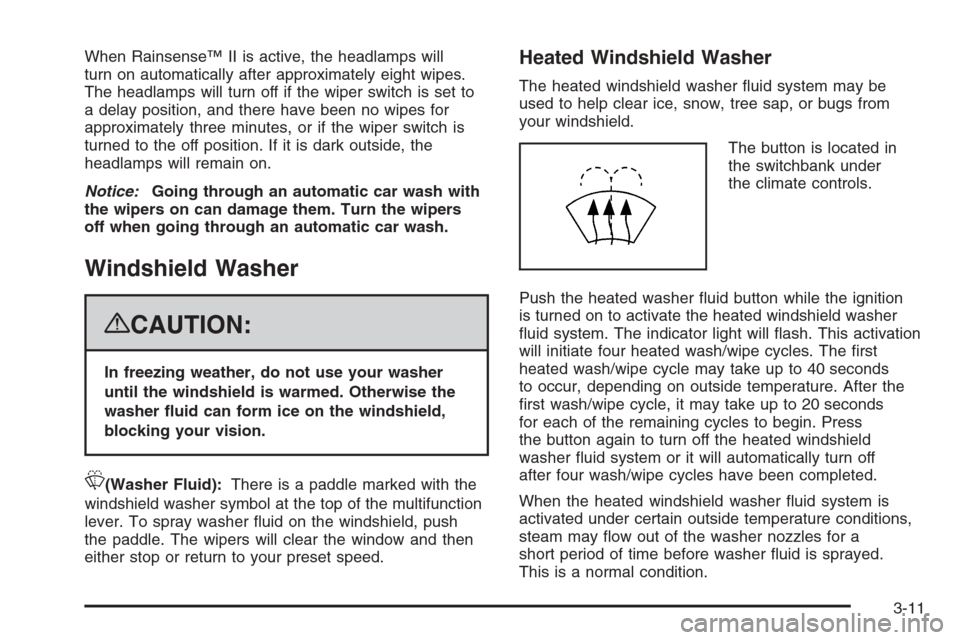
When Rainsense™ II is active, the headlamps will
turn on automatically after approximately eight wipes.
The headlamps will turn off if the wiper switch is set to
a delay position, and there have been no wipes for
approximately three minutes, or if the wiper switch is
turned to the off position. If it is dark outside, the
headlamps will remain on.
Notice:Going through an automatic car wash with
the wipers on can damage them. Turn the wipers
off when going through an automatic car wash.
Windshield Washer
{CAUTION:
In freezing weather, do not use your washer
until the windshield is warmed. Otherwise the
washer �uid can form ice on the windshield,
blocking your vision.
L(Washer Fluid):There is a paddle marked with the
windshield washer symbol at the top of the multifunction
lever. To spray washer �uid on the windshield, push
the paddle. The wipers will clear the window and then
either stop or return to your preset speed.
Heated Windshield Washer
The heated windshield washer �uid system may be
used to help clear ice, snow, tree sap, or bugs from
your windshield.
The button is located in
the switchbank under
the climate controls.
Push the heated washer �uid button while the ignition
is turned on to activate the heated windshield washer
�uid system. The indicator light will �ash. This activation
will initiate four heated wash/wipe cycles. The �rst
heated wash/wipe cycle may take up to 40 seconds
to occur, depending on outside temperature. After the
�rst wash/wipe cycle, it may take up to 20 seconds
for each of the remaining cycles to begin. Press
the button again to turn off the heated windshield
washer �uid system or it will automatically turn off
after four wash/wipe cycles have been completed.
When the heated windshield washer �uid system is
activated under certain outside temperature conditions,
steam may �ow out of the washer nozzles for a
short period of time before washer �uid is sprayed.
This is a normal condition.
3-11
Page 185 of 490

Reading Lamps
If your vehicle has reading lamps, press the button
located next to the lamp to turn it on or off.
Your vehicle may also have reading lamps in other
locations. To turn each one on or off, press the button
located next to the lamp. The lamps cannot be adjusted.
Electric Power Management
The vehicle has Electric Power Management (EPM)
that estimates the battery’s temperature and state
of charge. It then adjusts the voltage for best
performance and extended life of the battery.
When the battery’s state of charge is low, the voltage is
raised slightly to quickly put the charge back in. When
the state of charge is high, the voltage is lowered slightly
to prevent overcharging. If the vehicle has a voltmeter
gage or a voltage display on the Driver Information
Center (DIC), you may see the voltage move up
or down. This is normal. If there is a problem, an alert
will be displayed.The battery can be discharged at idle if the electrical
loads are very high. This is true for all vehicles.
This is because the generator (alternator) may not be
spinning fast enough at idle to produce all the power
that is needed for very high electrical loads.
A high electrical load occurs when several of the
following loads are on: headlamps, high beams, fog
lamps, rear window defogger, climate control fan at
high speed, heated seats, engine cooling fans, trailer
loads, and loads plugged into accessory power outlets.
EPM works to prevent excessive discharge of the
battery. It does this by balancing the generator’s output
and the vehicle’s electrical needs. It can increase
engine idle speed to generate more power, whenever
needed. It can temporarily reduce the power demands
of some accessories.
Normally, these actions occur in steps or levels, without
being noticeable. In rare cases at the highest levels
of corrective action, this action may be noticeable to
the driver. If so, a Driver Information Center (DIC)
message might be displayed, such as Battery Saver
Active or Service Battery Charging System. If this
message is displayed, it is recommended that the
driver reduce the electrical loads as much as possible.
SeeDIC Warnings and Messages on page 3-52.
3-23
Page 188 of 490
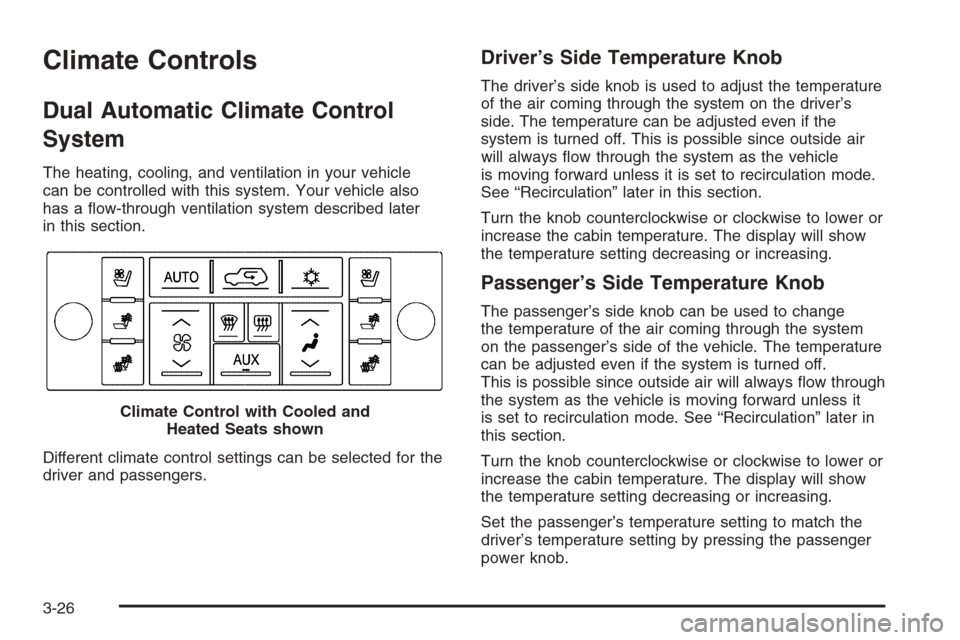
Climate Controls
Dual Automatic Climate Control
System
The heating, cooling, and ventilation in your vehicle
can be controlled with this system. Your vehicle also
has a �ow-through ventilation system described later
in this section.
Different climate control settings can be selected for the
driver and passengers.
Driver’s Side Temperature Knob
The driver’s side knob is used to adjust the temperature
of the air coming through the system on the driver’s
side. The temperature can be adjusted even if the
system is turned off. This is possible since outside air
will always �ow through the system as the vehicle
is moving forward unless it is set to recirculation mode.
See “Recirculation” later in this section.
Turn the knob counterclockwise or clockwise to lower or
increase the cabin temperature. The display will show
the temperature setting decreasing or increasing.
Passenger’s Side Temperature Knob
The passenger’s side knob can be used to change
the temperature of the air coming through the system
on the passenger’s side of the vehicle. The temperature
can be adjusted even if the system is turned off.
This is possible since outside air will always �ow through
the system as the vehicle is moving forward unless it
is set to recirculation mode. See “Recirculation” later in
this section.
Turn the knob counterclockwise or clockwise to lower or
increase the cabin temperature. The display will show
the temperature setting decreasing or increasing.
Set the passenger’s temperature setting to match the
driver’s temperature setting by pressing the passenger
power knob. Climate Control with Cooled and
Heated Seats shown
3-26
Page 189 of 490
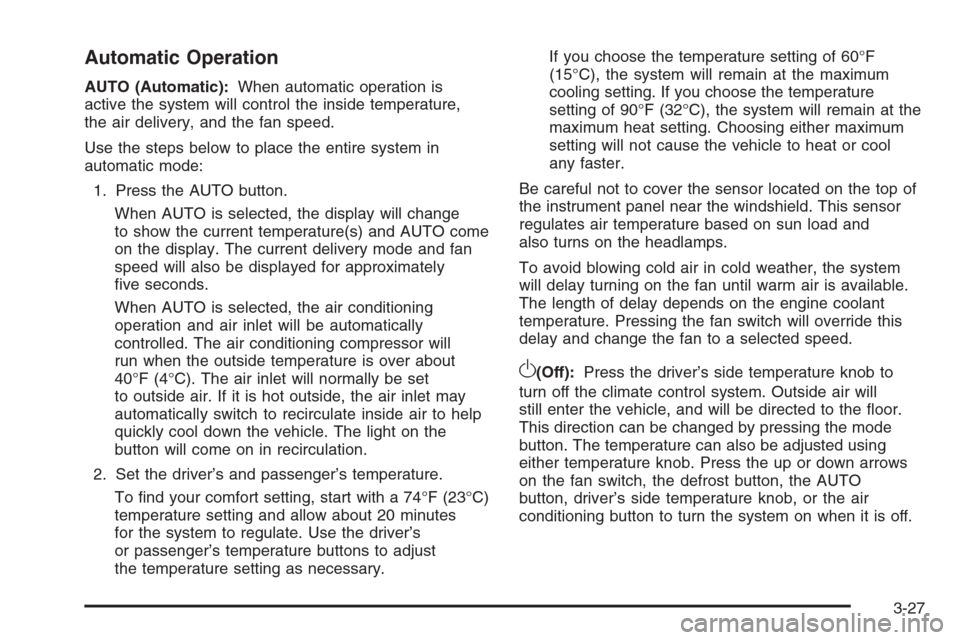
Automatic Operation
AUTO (Automatic):When automatic operation is
active the system will control the inside temperature,
the air delivery, and the fan speed.
Use the steps below to place the entire system in
automatic mode:
1. Press the AUTO button.
When AUTO is selected, the display will change
to show the current temperature(s) and AUTO come
on the display. The current delivery mode and fan
speed will also be displayed for approximately
�ve seconds.
When AUTO is selected, the air conditioning
operation and air inlet will be automatically
controlled. The air conditioning compressor will
run when the outside temperature is over about
40°F (4°C). The air inlet will normally be set
to outside air. If it is hot outside, the air inlet may
automatically switch to recirculate inside air to help
quickly cool down the vehicle. The light on the
button will come on in recirculation.
2. Set the driver’s and passenger’s temperature.
To �nd your comfort setting, start with a 74°F (23°C)
temperature setting and allow about 20 minutes
for the system to regulate. Use the driver’s
or passenger’s temperature buttons to adjust
the temperature setting as necessary.If you choose the temperature setting of 60°F
(15°C), the system will remain at the maximum
cooling setting. If you choose the temperature
setting of 90°F (32°C), the system will remain at the
maximum heat setting. Choosing either maximum
setting will not cause the vehicle to heat or cool
any faster.
Be careful not to cover the sensor located on the top of
the instrument panel near the windshield. This sensor
regulates air temperature based on sun load and
also turns on the headlamps.
To avoid blowing cold air in cold weather, the system
will delay turning on the fan until warm air is available.
The length of delay depends on the engine coolant
temperature. Pressing the fan switch will override this
delay and change the fan to a selected speed.
O(Off):Press the driver’s side temperature knob to
turn off the climate control system. Outside air will
still enter the vehicle, and will be directed to the �oor.
This direction can be changed by pressing the mode
button. The temperature can also be adjusted using
either temperature knob. Press the up or down arrows
on the fan switch, the defrost button, the AUTO
button, driver’s side temperature knob, or the air
conditioning button to turn the system on when it is off.
3-27
Page 191 of 490
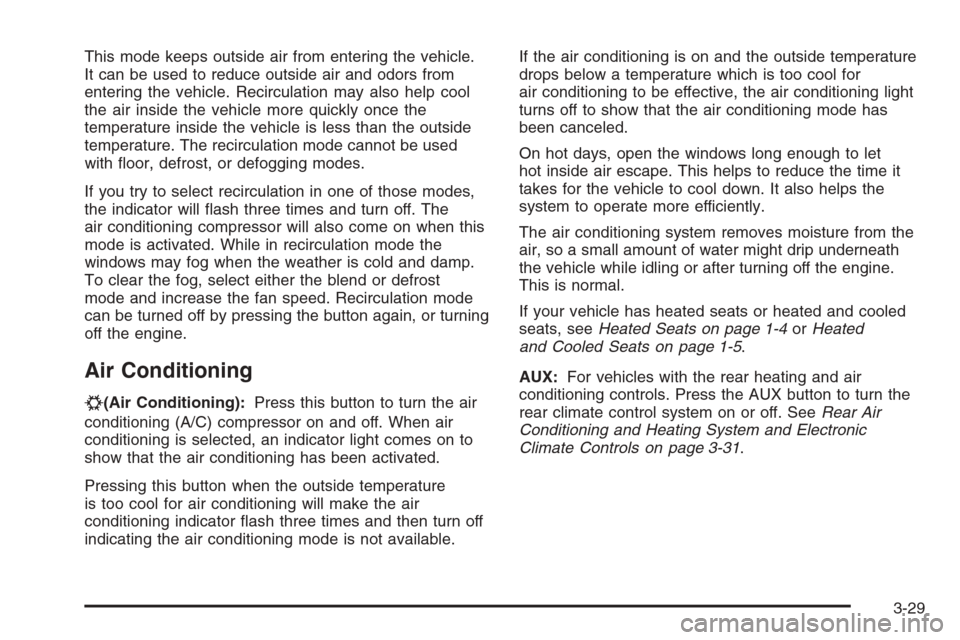
This mode keeps outside air from entering the vehicle.
It can be used to reduce outside air and odors from
entering the vehicle. Recirculation may also help cool
the air inside the vehicle more quickly once the
temperature inside the vehicle is less than the outside
temperature. The recirculation mode cannot be used
with �oor, defrost, or defogging modes.
If you try to select recirculation in one of those modes,
the indicator will �ash three times and turn off. The
air conditioning compressor will also come on when this
mode is activated. While in recirculation mode the
windows may fog when the weather is cold and damp.
To clear the fog, select either the blend or defrost
mode and increase the fan speed. Recirculation mode
can be turned off by pressing the button again, or turning
off the engine.
Air Conditioning
#
(Air Conditioning):Press this button to turn the air
conditioning (A/C) compressor on and off. When air
conditioning is selected, an indicator light comes on to
show that the air conditioning has been activated.
Pressing this button when the outside temperature
is too cool for air conditioning will make the air
conditioning indicator �ash three times and then turn off
indicating the air conditioning mode is not available.If the air conditioning is on and the outside temperature
drops below a temperature which is too cool for
air conditioning to be effective, the air conditioning light
turns off to show that the air conditioning mode has
been canceled.
On hot days, open the windows long enough to let
hot inside air escape. This helps to reduce the time it
takes for the vehicle to cool down. It also helps the
system to operate more efficiently.
The air conditioning system removes moisture from the
air, so a small amount of water might drip underneath
the vehicle while idling or after turning off the engine.
This is normal.
If your vehicle has heated seats or heated and cooled
seats, seeHeated Seats on page 1-4orHeated
and Cooled Seats on page 1-5.
AUX:For vehicles with the rear heating and air
conditioning controls. Press the AUX button to turn the
rear climate control system on or off. SeeRear Air
Conditioning and Heating System and Electronic
Climate Controls on page 3-31.
3-29
Page 192 of 490

Defogging and Defrosting
Fog on the inside of the windows is a result of high
humidity (moisture) condensing on the cool window
glass. This can be minimized if the climate control
system is used properly. There are two modes to clear
fog or frost from your windshield. Use the defog
mode to clear the windows of fog or moisture and warm
the passengers. Use the defrost mode to remove fog
or frost from the windshield more quickly.
Use the mode up and down arrows to select the defog
or defrost modes.
-(Defog):This mode directs air to the windshield,
�oor outlets, and side window vents. When this mode
is selected, the system turns off recirculation and
runs the air conditioning compressor unless the outside
temperature is close to freezing. The recirculation
mode cannot be selected while in the defog mode.
Do not drive the vehicle until all the windows are clear.
0(Defrost):This mode directs a portion of the
air to the windshield and side window vents and
some to the �oor vents. In this mode, the system
will automatically force outside air into the vehicle.The recirculation mode cannot be selected while in the
defrost mode. The air conditioning compressor will
run automatically in this setting, unless the outside
temperature is close to freezing. Do not drive the
vehicle until all the windows are clear.
Rear Window Defogger
The rear window defogger uses a warming grid to
remove fog from the rear window.
<(Rear Window Defogger):The rear window
defogger will turn off automatically after it has been
activated. The defogger can also be turned off by
pressing the button again or by turning off the engine.
Do not drive the vehicle until all the windows are clear.
If your vehicle has heated outside rearview mirrors,
the mirrors will heat to help clear fog or frost from the
surface of the mirror when the rear window defog button
is pressed.
Notice:Do not use a razor blade or sharp object
to clear the inside rear window. Do not adhere
anything to the defogger grid lines in the rear glass.
These actions may damage the rear defogger.
Repairs would not be covered by your warranty.
3-30
Page 193 of 490
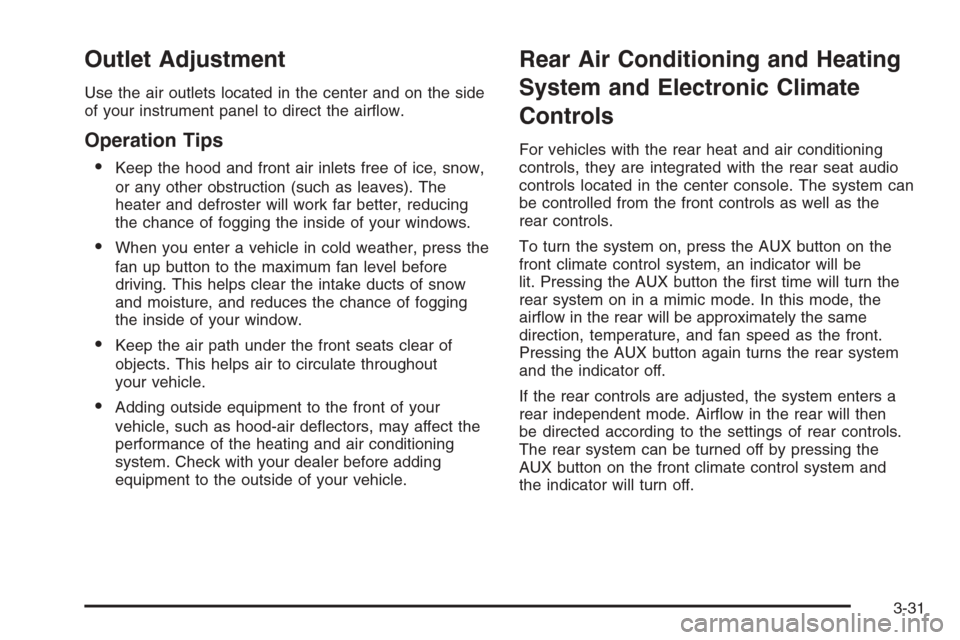
Outlet Adjustment
Use the air outlets located in the center and on the side
of your instrument panel to direct the air�ow.
Operation Tips
Keep the hood and front air inlets free of ice, snow,
or any other obstruction (such as leaves). The
heater and defroster will work far better, reducing
the chance of fogging the inside of your windows.
When you enter a vehicle in cold weather, press the
fan up button to the maximum fan level before
driving. This helps clear the intake ducts of snow
and moisture, and reduces the chance of fogging
the inside of your window.
Keep the air path under the front seats clear of
objects. This helps air to circulate throughout
your vehicle.
Adding outside equipment to the front of your
vehicle, such as hood-air de�ectors, may affect the
performance of the heating and air conditioning
system. Check with your dealer before adding
equipment to the outside of your vehicle.
Rear Air Conditioning and Heating
System and Electronic Climate
Controls
For vehicles with the rear heat and air conditioning
controls, they are integrated with the rear seat audio
controls located in the center console. The system can
be controlled from the front controls as well as the
rear controls.
To turn the system on, press the AUX button on the
front climate control system, an indicator will be
lit. Pressing the AUX button the �rst time will turn the
rear system on in a mimic mode. In this mode, the
air�ow in the rear will be approximately the same
direction, temperature, and fan speed as the front.
Pressing the AUX button again turns the rear system
and the indicator off.
If the rear controls are adjusted, the system enters a
rear independent mode. Air�ow in the rear will then
be directed according to the settings of rear controls.
The rear system can be turned off by pressing the
AUX button on the front climate control system and
the indicator will turn off.
3-31
Page 194 of 490
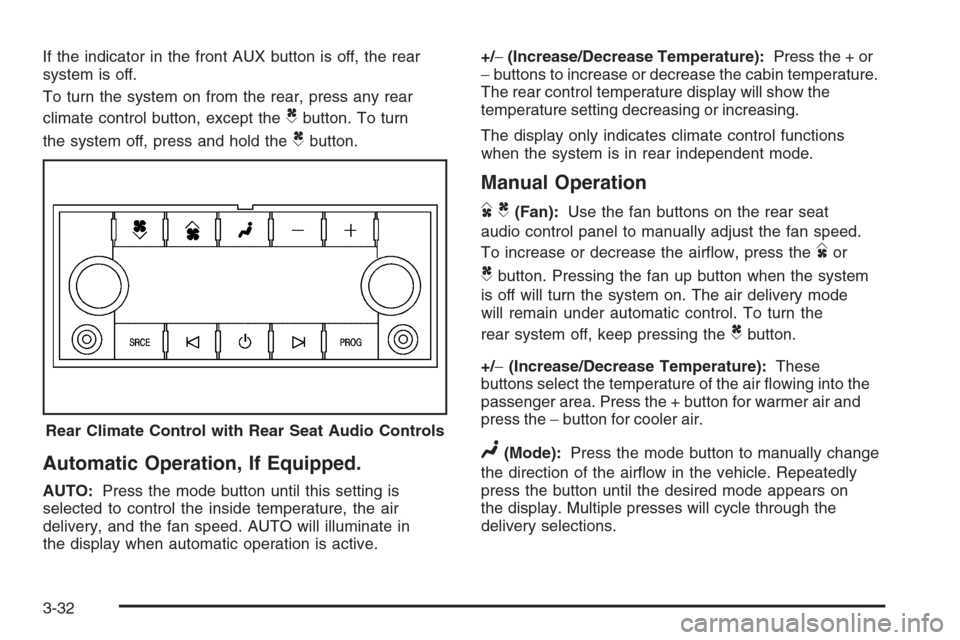
If the indicator in the front AUX button is off, the rear
system is off.
To turn the system on from the rear, press any rear
climate control button, except the
Cbutton. To turn
the system off, press and hold the
Cbutton.
Automatic Operation, If Equipped.
AUTO:Press the mode button until this setting is
selected to control the inside temperature, the air
delivery, and the fan speed. AUTO will illuminate in
the display when automatic operation is active.+/−(Increase/Decrease Temperature):Press the + or
−buttons to increase or decrease the cabin temperature.
The rear control temperature display will show the
temperature setting decreasing or increasing.
The display only indicates climate control functions
when the system is in rear independent mode.
Manual Operation
DC(Fan):Use the fan buttons on the rear seat
audio control panel to manually adjust the fan speed.
To increase or decrease the air�ow, press the
Dor
Cbutton. Pressing the fan up button when the system
is off will turn the system on. The air delivery mode
will remain under automatic control. To turn the
rear system off, keep pressing the
Cbutton.
+/−(Increase/Decrease Temperature):These
buttons select the temperature of the air �owing into the
passenger area. Press the + button for warmer air and
press the−button for cooler air.
N(Mode):Press the mode button to manually change
the direction of the air�ow in the vehicle. Repeatedly
press the button until the desired mode appears on
the display. Multiple presses will cycle through the
delivery selections. Rear Climate Control with Rear Seat Audio Controls
3-32